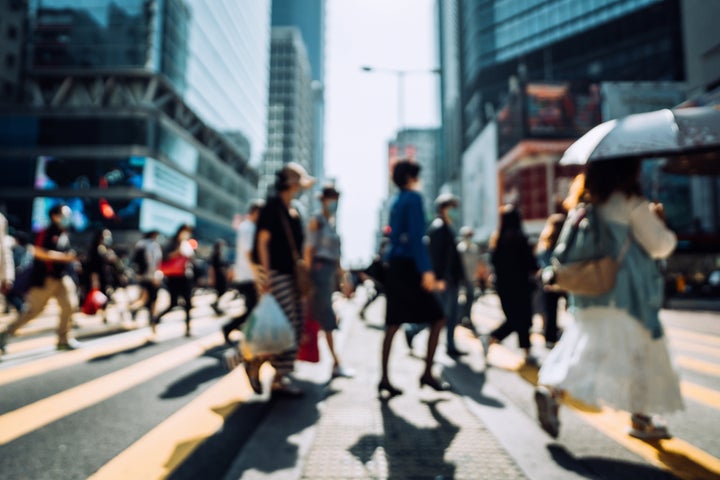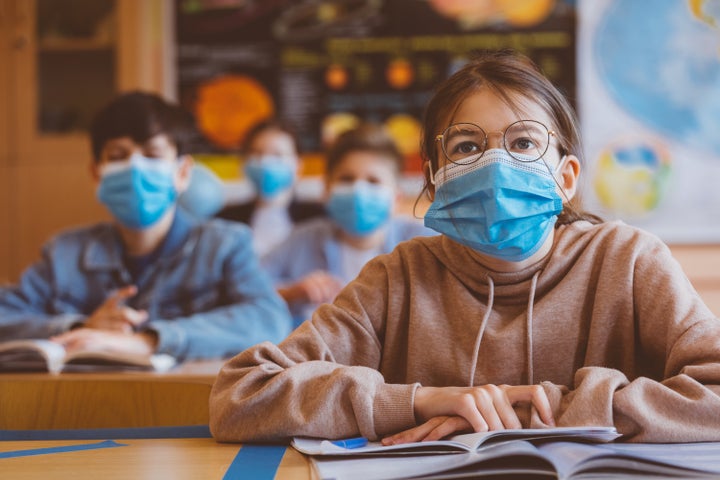
For the first time in a long time, the U.S. is at a hopeful moment in the COVID-19 pandemic. More than half of adults have received at least one dose of a coronavirus vaccine, and the seven-day average of new cases has decreased by roughly 80% since its January 2021 peak. The director of the Centers for Disease Control and Prevention has said she’s “cautiously optimistic” that the country is turning a corner.
But turning a corner isn’t necessarily the same thing as achieving herd immunity or eradicating the virus altogether — particularly as the pace of vaccinations begins to slow and new variants emerge. So HuffPost asked several experts to share their expectations for what might come next, based on where we are right now.
Many experts now doubt that national herd immunity is possible.
Herd immunity is achieved when a large enough portion of a community becomes immune to a disease (either through natural infection or vaccination) that there’s nowhere left for the virus to spread. There may still be small outbreaks, but they would be contained. (That’s different than eradicating the disease altogether, which has only ever been done twice in global history, with smallpox and rinderpest, a bovine disease.)
But many experts now believe it’s unlikely the U.S. will ever achieve herd immunity.
As science reporter Apoorva Mandavilli wrote in The New York Times, “rather than making a long-promised exit, the virus will most likely become a manageable threat that will continue to circulate in the United States for years to come, still causing hospitalizations and deaths but in much smaller numbers.”
There are several reasons for that more pessimistic take, though the biggest one is that not enough Americans will get vaccinated. Current estimates suggest somewhere between 70% and 85% of the population needs to be vaccinated in order to achieve the herd immunity threshold for COVID-19 — although that’s just a best guess.
But in states like Wyoming, Montana, North Dakota, Kentucky and Ohio, between 20% and 25% of adults have said flat-out that they have no intention of getting vaccinated. And many more have said they’re unsure.
One possibility is that we’ll have something that looks more like regional herd immunity, rather than nationwide immunity — and that communities will impose short-lived restrictions accordingly.
“We might have different levels of herd immunity,” infectious diseases expert Stuart Ray, vice chair of medicine for data integrity with Johns Hopkins Medicine, told HuffPost. “In the future, we might look at something more meaningful than a national level of herd immunity. Because it might not make sense to worry about California if you’re in Buffalo, New York. You might worry about Ontario. It’s almost a question of: Which herd are you going to worry about?”
If the U.S. has any chance at broad herd immunity, it’s not enough to get enough people vaccinated ― it must also happen quickly.
For months now, experts have warned that the vaccination rollout is in a race with coronavirus variants. That’s because the more opportunities the virus has to spread from person to person, the more chances it has to mutate and continue to infect others.
“If we have variants that evade immune responses that we’ve developed through vaccination or infection, we might see increasing rates again,” Ray said.

Where we are this fall will likely tell us a lot about where we’re headed long-term.
Ray told HuffPost he is optimistic that we will be in a “lull” in the pandemic this summer, primarily because of vaccination, but also because the virus in the U.S. appears to wane that time of year, for reasons that are not understood. It could simply be that people are more likely to gather outdoors in the summer, where the transmission risk is lower. But ultraviolet light might also play a role.
However, that lull could still be followed by another surge — and at this point, it’s too soon to say.
“Even if we are at a degree of herd immunity right now, it might be situational because of the environment and the coming summer; it might be situational because we have the variants we have right now, but there might be new ones on the horizon because there’s lots of evolution happening every day. And come the fall, we may have a different set of conditions,” Ray said. “The most science-based response to that, I think, is to get as many people vaccinated as possible. Because we know that vaccination is highly protective and probably limits spread.”
If, after the summer, case numbers and hospitalizations look like they’re remaining relatively low, it’s safe to imagine that restrictions on mask-wearing, group get-togethers and even indoor gatherings could be relaxed long-term, although that is just speculative at this point.
Also, as we head from the fall into the winter, experts will start to get a clearer sense of how long protection from COVID-19 vaccination lasts — and whether it is necessary to provide booster shots or “retool” the vaccines in any way, as Ray put it.
“We don’t have a test today that if I were to administer it to a patient I’d be able to say: ‘OK, you’re immune right now.’ Or: ‘Oops, now it’s negative so I need to revaccinate you,’” he said.

Children are a big question mark in all of this.
The Pfizer vaccine is expected to be approved for children ages 12 to 15 any day now, and older teenagers have been eligible to roll up their sleeves since earlier this spring. And because there may be millions of adult vaccine holdouts, experts increasingly believe that widespread vaccination of children could really shape what comes.
“Kids most certainly have a part to play,” Dr. Steven Abelowitz, a pediatrician with Coastal Kids Pediatrics in Orange County, California, told HuffPost. “Getting them vaccinated will help us reach herd immunity.”
But at this point, many parents say they are reluctant to have their children roll up their sleeves. According to recent survey data from the Kaiser Family Foundation, 30% of parents with 12- to 15-year-olds say they will get their child vaccinated as soon as a vaccine is available; 25% say they will wait awhile to see how the vaccine is working, 18% say they plan to get their child vaccinated if their school requires it, while roughly 25% say they will definitely not get their child vaccinated.
Ultimately, it may be more useful to focus on a return to ‘normality’ rather than herd immunity.
In February, Youyang Gu, an independent data scientist with a popular COVID-19 forecasting model, changed its name from the “Path to Herd Immunity” to the “Path to Normality.” He tweeted about the shift at the time, but told HuffPost it is only being widely talked about recently, as there’s been broader awareness that national herd immunity simply may not happen.
However, he believes the U.S. will return to “normal” — by which he means most states will have lifted all COVID-19 restrictions because hospitalizations and deaths are low enough — sometime this summer, between June and August. So even though the virus will still be circulating, people will largely be back to their pre-pandemic routines.
As Gu tweeted several months ago: “By summer, everybody who wants a vaccine will be able to get one. The vulnerable population will long have been able to receive their shots. Hospitalizations & deaths will be at negligible levels. Normality will happen... with or without herd immunity.” (Gu frequently reminds his audience he is a data scientist, not a public health expert or epidemiologist.)
Last January, the journal Nature polled 100 immunologists, infectious disease experts and virologists about whether they believe the virus could be eradicated. Nearly 90% said they believe it will become endemic, meaning it circulates in pockets globally indefinitely. There could be localized outbreaks in the U.S. and they might be seasonal — waning in the spring and summer and picking up in the fall.
But whether the goal is herd immunity or a return to normality, getting more Americans vaccinated — as soon as possible — is essential.
“I think if we really got deliberate at achieving vaccination rates at very high levels, we could really tamp this down and prevent a big surge in the fall,” Ray said.
Experts are still learning about COVID-19. The information in this story is what was known or available as of publication, but guidance can change as scientists discover more about the virus. Please check the Centers for Disease Control and Prevention for the most updated recommendations.